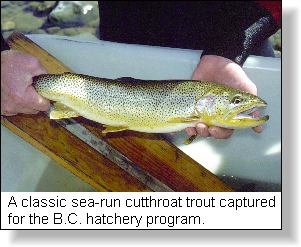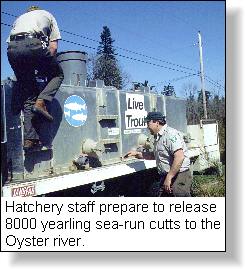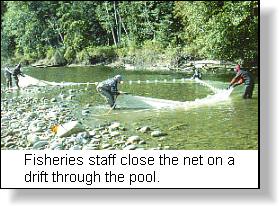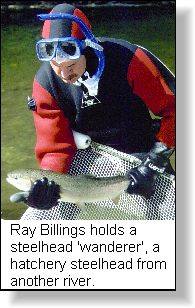
BC Outdoor Odyssey
"Sea-Run Cutthroat Trout"
with Barry M. Thornton

Tinsel Trout, Harvest Trout, Yellowbellies, Sea Runs, Cutts, these are
just some of the names which anglers call the coastal sea-run cutthroat
trout. The first two names are associated with the time that these spunky
sports trout enter their various home rivers to feed on salmon fry in the
spring or, salmon eggs in the fall. The latter names are those affectionately
used by B.C. anglers who have had a long association with this special trout.
 One of the greatest concentrations of these most desired sports
fish is in the very accessible Oyster River on the east coast of Vancouver
Island. Every year hundreds of anglers, fly fishers, spin fishermen,
and bait fishers hike the lower miles of the river in search of these
exciting trout. Thanks to the efforts of the provincial Fisheries Branch
their search is rarely in vain for during the past decade the Fisheries
Branch has provided a major hatchery stocking program in the Oyster
river using brood stock taken from that river. One of the greatest concentrations of these most desired sports
fish is in the very accessible Oyster River on the east coast of Vancouver
Island. Every year hundreds of anglers, fly fishers, spin fishermen,
and bait fishers hike the lower miles of the river in search of these
exciting trout. Thanks to the efforts of the provincial Fisheries Branch
their search is rarely in vain for during the past decade the Fisheries
Branch has provided a major hatchery stocking program in the Oyster
river using brood stock taken from that river.
Last autumn I watched Vancouver Island Fisheries staff, under the direction
of Rick Axford of Region 1 Fisheries management, net the river in their
annual search for brood stock adults. It was an impressive sight. Earlier
in the day, in teams of two, Fisheries officials swam the river using snorkels
to count the numbers of fish in the river. While swimming they were able
to locate the greatest concentrations of fish in the river for purposes
of netting.
When I arrived at the river they had made their pool selection estimating
that a few hundred sea-run cutts rested in one particular pool. With the
help of angler volunteers, I watched and photographed as they pulled a net
across the head of the pool and then dragged it down through the pool. To
keep the fish from escaping downstream, members splashed the water in the
shallows at the tailout chasing them back into the net.
 According to Ray Billings, Manager, Vancouver Island Trout Hatchery,
Fish Culture Section, Ministry of Environment, Lands & Parks, who
was assisting with the brood capture, what they required were 15 adult
pairs for hatchery purposes. On the first drift through the pool about
six pair were captured in the net. These were subsequently netted by
small hand nets and placed in special holding buckets for later examination.
Later, those selected would be transferred to the Ministry of Environment
fish tank truck for transporting to the Duncan hatchery. According to Ray Billings, Manager, Vancouver Island Trout Hatchery,
Fish Culture Section, Ministry of Environment, Lands & Parks, who
was assisting with the brood capture, what they required were 15 adult
pairs for hatchery purposes. On the first drift through the pool about
six pair were captured in the net. These were subsequently netted by
small hand nets and placed in special holding buckets for later examination.
Later, those selected would be transferred to the Ministry of Environment
fish tank truck for transporting to the Duncan hatchery.
A second swing through the pool netted even more sea-run cutts along
with pink salmon, coho
adults, jacks and numerous salmon fry species, and, a fresh run bright adult
hatchery steelhead easily identified by it's clipped adipose fin. All these
species came from the one single pool, a sign of just how productive is
the Oyster river.
On the third drift they completed the take necessary for the numbers
of sea-run cutthroat trout needed but, this time, they also netted an adult
Atlantic salmon. This latter fish has been taken to the biological station
at Nanaimo for
study. It seems that Atlantic salmon are now being caught in many mid and
north Island river systems. These are fish that have escaped from commercial
net pens situated in B.C. fjords.
 During one break in the netting I talked with Ray Billings and
asked him what would be the next stage for these captured brood fish.
He told me that they would be transported to the old provincial hatchery
site at Duncan
where they would be held and fed for the next three months. Fisheries
will then spawn these adults, usually between January and February,
until they have the needed 12,000 eggs which will result in approximately
10,000 smolts. The adult fish are left at the old hatchery for the entire
time until they are returned and released back to the Oyster river.
Fisheries will transfer disinfected eggs from the old hatchery to the
new hatchery. Here they are to be incubated in isolation and the eggs
will hatch in late March/early April. The fry will be raised in this
new hatchery to be released one year later in the Oyster river. Ray
told me that virus sampling is done as a precaution and that, "This
new hatchery has never encountered a virus but, we are always checking." During one break in the netting I talked with Ray Billings and
asked him what would be the next stage for these captured brood fish.
He told me that they would be transported to the old provincial hatchery
site at Duncan
where they would be held and fed for the next three months. Fisheries
will then spawn these adults, usually between January and February,
until they have the needed 12,000 eggs which will result in approximately
10,000 smolts. The adult fish are left at the old hatchery for the entire
time until they are returned and released back to the Oyster river.
Fisheries will transfer disinfected eggs from the old hatchery to the
new hatchery. Here they are to be incubated in isolation and the eggs
will hatch in late March/early April. The fry will be raised in this
new hatchery to be released one year later in the Oyster river. Ray
told me that virus sampling is done as a precaution and that, "This
new hatchery has never encountered a virus but, we are always checking."
The following spring I received an email message from Ray saying that they
were going to release 8000 sea-run cutthroat trout in the lower Oyster river
the next day. These were the progeny of the autumn catch and I was most
interested to see how this brood stock had fared. Two large hatchery trucks
met me on Glenmore road and we drove to the release pool. Using a long flexible
pipe attached to the tanks on the back of the trucks hatchery staff sought
a safe section at the edge of the pool and began to pump the cutts into
the river. In a few minutes it was done and the river was dotted with pastel
green fish adjusting and acclimatizing to their home river. These were very
healthy fish and I commend fisheries staff for the care with which they
handled these beautiful 5 to 8 inch trout during the stocking.
Ray was very enthusiastic about the Oyster river sea-run cutthroat trout
program indicating that it had a high priority in Vancouver Island sports
fisheries management. "It is a popular fishery," he said "with
the primary goal being to provide an easily accessible hatchery and wild
mix of sea-run cutthroat trout for Island anglers". As one angler who
has fished my cherished Oyster river for many years, I heartily endorse
the work and efforts of Fisheries on my glorious home stream.
© Copyright Barry M. Thornton
Barry M. Thornton
|





 One of the greatest concentrations of these most desired sports
fish is in the very accessible Oyster River on the east coast of
One of the greatest concentrations of these most desired sports
fish is in the very accessible Oyster River on the east coast of  According to Ray Billings, Manager, Vancouver Island Trout Hatchery,
Fish Culture Section, Ministry of Environment, Lands & Parks, who
was assisting with the brood capture, what they required were 15 adult
pairs for hatchery purposes. On the first drift through the pool about
six pair were captured in the net. These were subsequently netted by
small hand nets and placed in special holding buckets for later examination.
Later, those selected would be transferred to the Ministry of Environment
fish tank truck for transporting to the Duncan hatchery.
According to Ray Billings, Manager, Vancouver Island Trout Hatchery,
Fish Culture Section, Ministry of Environment, Lands & Parks, who
was assisting with the brood capture, what they required were 15 adult
pairs for hatchery purposes. On the first drift through the pool about
six pair were captured in the net. These were subsequently netted by
small hand nets and placed in special holding buckets for later examination.
Later, those selected would be transferred to the Ministry of Environment
fish tank truck for transporting to the Duncan hatchery. During one break in the netting I talked with Ray Billings and
asked him what would be the next stage for these captured brood fish.
He told me that they would be transported to the old provincial hatchery
site at
During one break in the netting I talked with Ray Billings and
asked him what would be the next stage for these captured brood fish.
He told me that they would be transported to the old provincial hatchery
site at